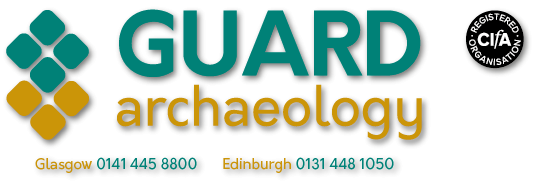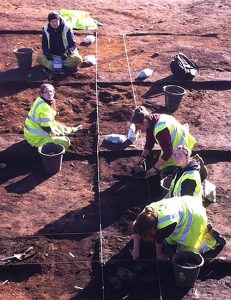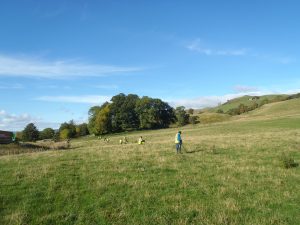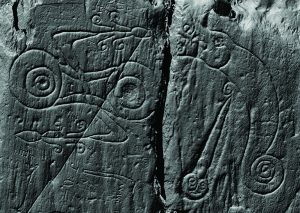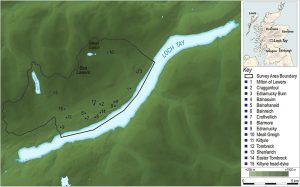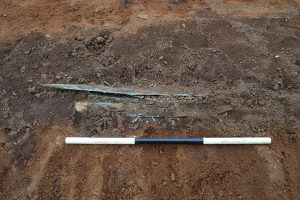
The Bronze Age Hoard as it was first revealed during excavations at Carnoustie © GUARD Archaeology Ltd
GUARD Archaeologists have recently recovered a very rare and internationally significant hoard of metalwork that is a major addition to Scottish Late Bronze Age archaeology.
A bronze spearhead decorated with gold was found alongside a bronze sword, pin and scabbard fittings in a pit close to a Bronze Age settlement excavated by a team of GUARD Archaeologists led by Alan Hunter Blair, on behalf of Angus Council in advance of their development of two football pitches at Carnoustie.
Each individual object in the hoard is significant but the presence of gold ornament on the spearhead makes this an exceptional group. Within Britain and Ireland, only a handful of such spearheads are known – among them a weapon hoard found in 1963 at Pyotdykes Farm to the west of Dundee. These two weapon hoards from Angus – found only a few kilometres apart – hint at the wealth of the local warrior society during the centuries around 1000-800 BC.
There are two more aspects that elevate the Carnoustie discovery to international significance. The first aspect is the extremely rare survival of organic remains. A leather and wooden scabbard encased the Carnoustie sword and is probably the best preserved Late Bronze Age sword scabbard ever found in Britain. Fur skin survives around the spearhead, and textile around the pin and scabbard. Such organic remains rarely survive on dryland sites.
The second aspect is that the hoard is not an isolated find but was buried within a Late Bronze Age settlement, which means that once the excavation has been completed it will be possible to study the archaeological context of the hoard, revealing new insights into the local Bronze Age community that buried it. Not least of which was the longevity of settlement here. For the excavation has also revealed the largest Neolithic hall so far found in Scotland, a building dating to around 4000 BC and that may have been as old to the people who buried the weapon hoard, as they are to us.
‘It is very unusual to recover such artefacts in a modern archaeological excavation, which can reveal so much about the context of its burial. Owing to the fragile nature of these remains when we first discovered them, our team removed the entire pit, and the surrounding subsoil which it was cut into, as a single 80 kg block of soil,’ said GUARD Project Officer Alan Hunter Blair. ‘This was then delivered to our Finds Lab where it was assessed by a specialist Finds Conservator to plan how it could be carefully excavated and the artefacts conserved.’
‘Organic evidence like Bronze Age wooden scabbards rarely survive so this just underlines how extraordinary these finds are,’ said GUARD Project Officer, Beth Spence, who undertook the excavation of the hoard in GUARD Archaeology’s Finds Lab along with Conservator Will Murray from the Scottish Conservation Studio.
Along with the hoard, the GUARD Archaeology team have discovered around 1000 archaeological features, among them the remains of up to 12 sub-circular houses that probably date to the Bronze Age along with the remains of 2 rectilinear halls that likely date to the Neolithic period. Some of the other archaeology on site consists of clusters of large pits containing discarded, broken pots and lithic artefacts. It is unclear yet if the archaeological remains comprise a settlement that lasted from the Neolithic until the Late Bronze Age or if it comprises several settlements built upon the same site but separated in time by many centuries.
Claire Herbert of ACAS, Archaeological advisers to Angus Council, said ‘The archaeology uncovered at Carnoustie is undoubtedly of national and international significance, and will certainly further enhance our knowledge of the prehistory of this area, providing an invaluable opportunity to learn more about how people in Angus lived in the Neolithic and Bronze Age.’
Angus Council communities convener Donald Morrison added: ‘It is clear that Carnoustie was as much a hive of activity in Neolithic and Bronze Age times as it is now. The discoveries made on land destined for sporting development have given us a fascinating insight into our Angus forebears and I look forward to learning more about our local prehistory.’
Vice convener Jeanette Gaul said: ‘To make such a find while preparing to create sports facilities for Carnoustie came as a huge surprise to us all. We’ve since learned it is of national and, indeed, international importance. But I am pleased that the archaeologists have involved local young people in the excavation project and are offering us all an insight into Angus’ distant past.’
In tandem with the excavation, GUARD Archaeology have brought community benefits and added value to the work by providing tours and presentations for local schools, including Carnoustie High School and Monifieth High School. Work experience for two students (from Carnoustie High School and Brechin High School) was also provided. Each of the students were trained in core skills in archaeology and were provided with a bespoke training plan and an archaeology skills passport for potential future careers in archaeology. In addition, GUARD Archaeology provided employment throughout the contract for a recently graduated archaeologist from Dundee. Throughout the project GUARD Archaeology have strived to use local suppliers and resources so that as much of the contract value as possible goes back into the local economy.
